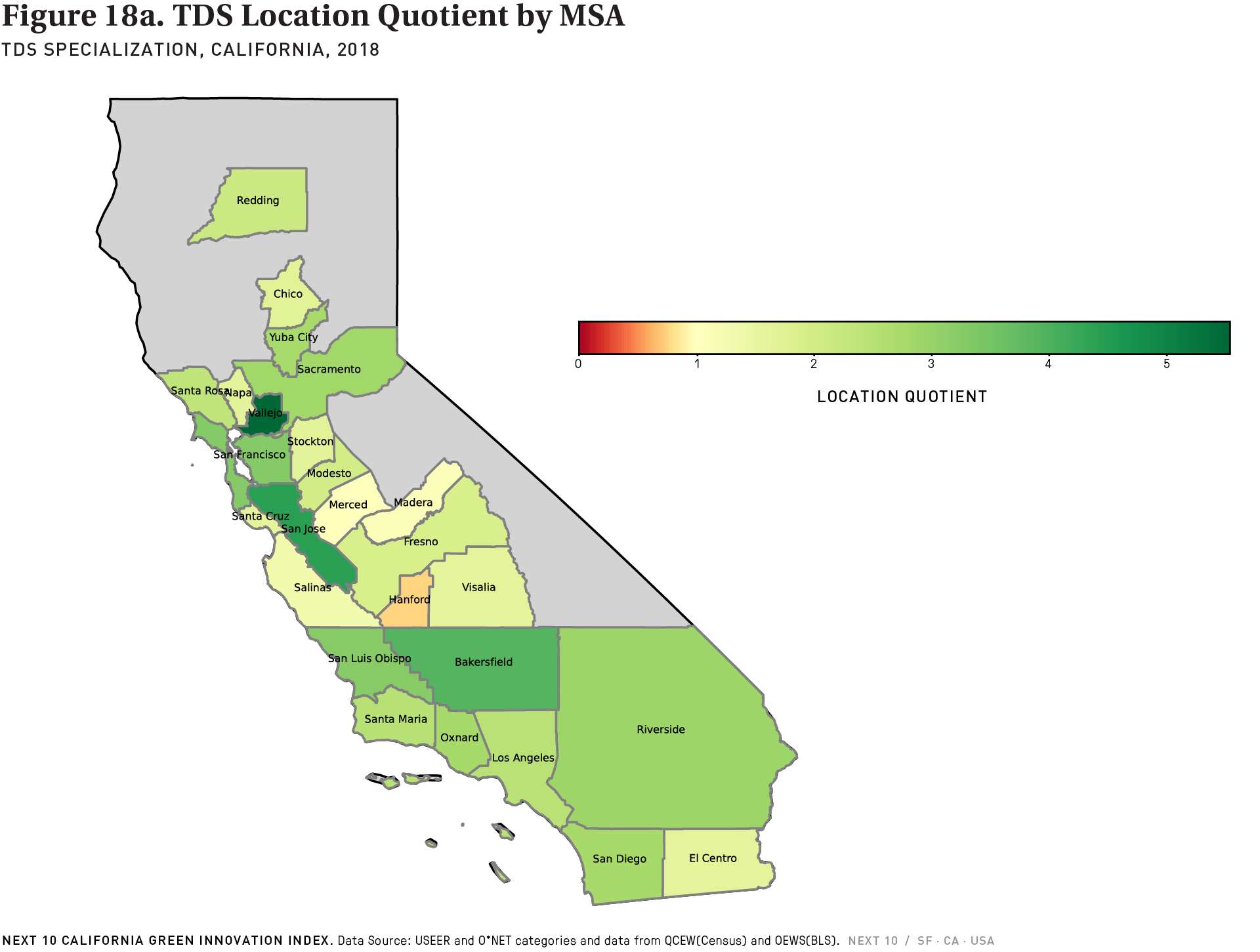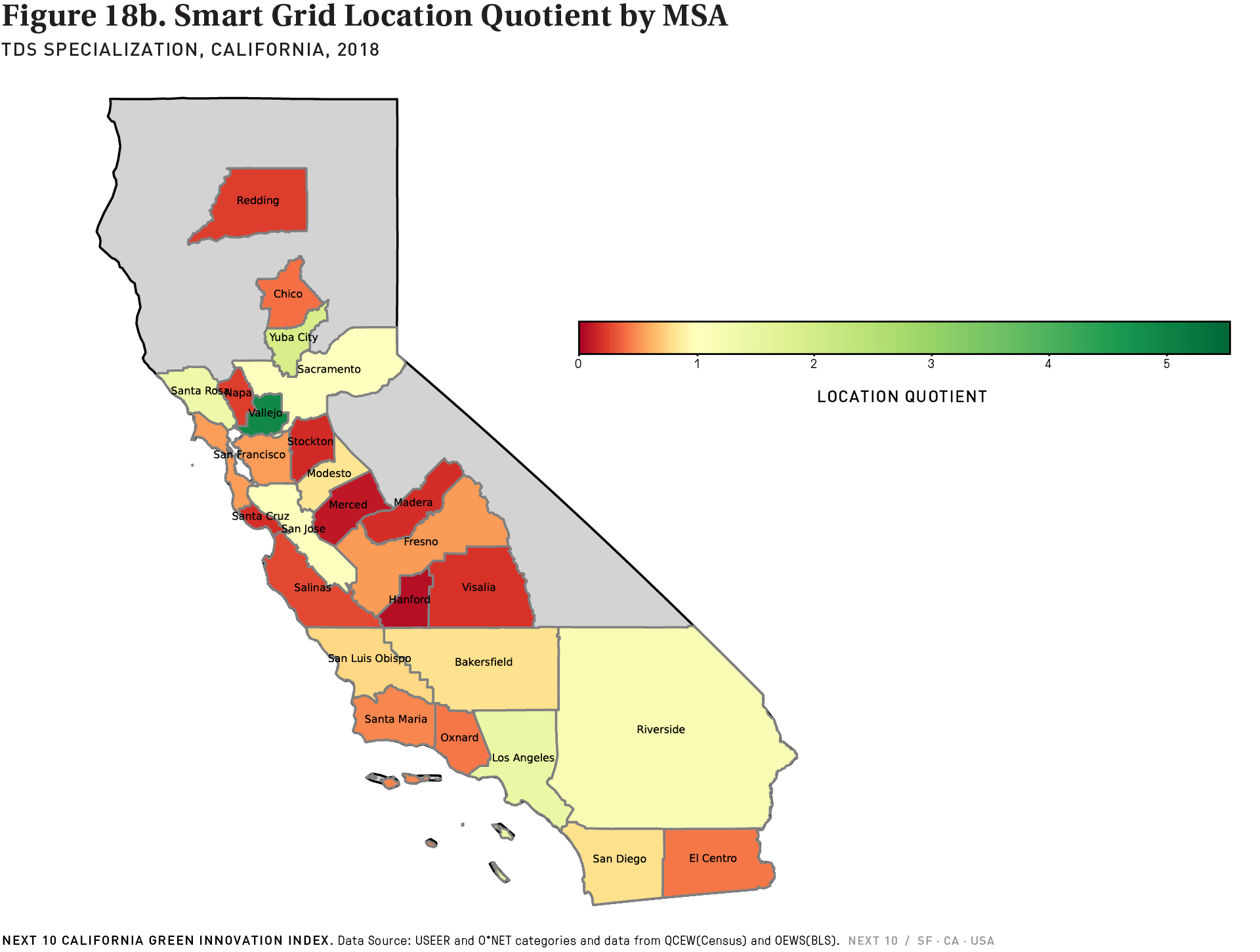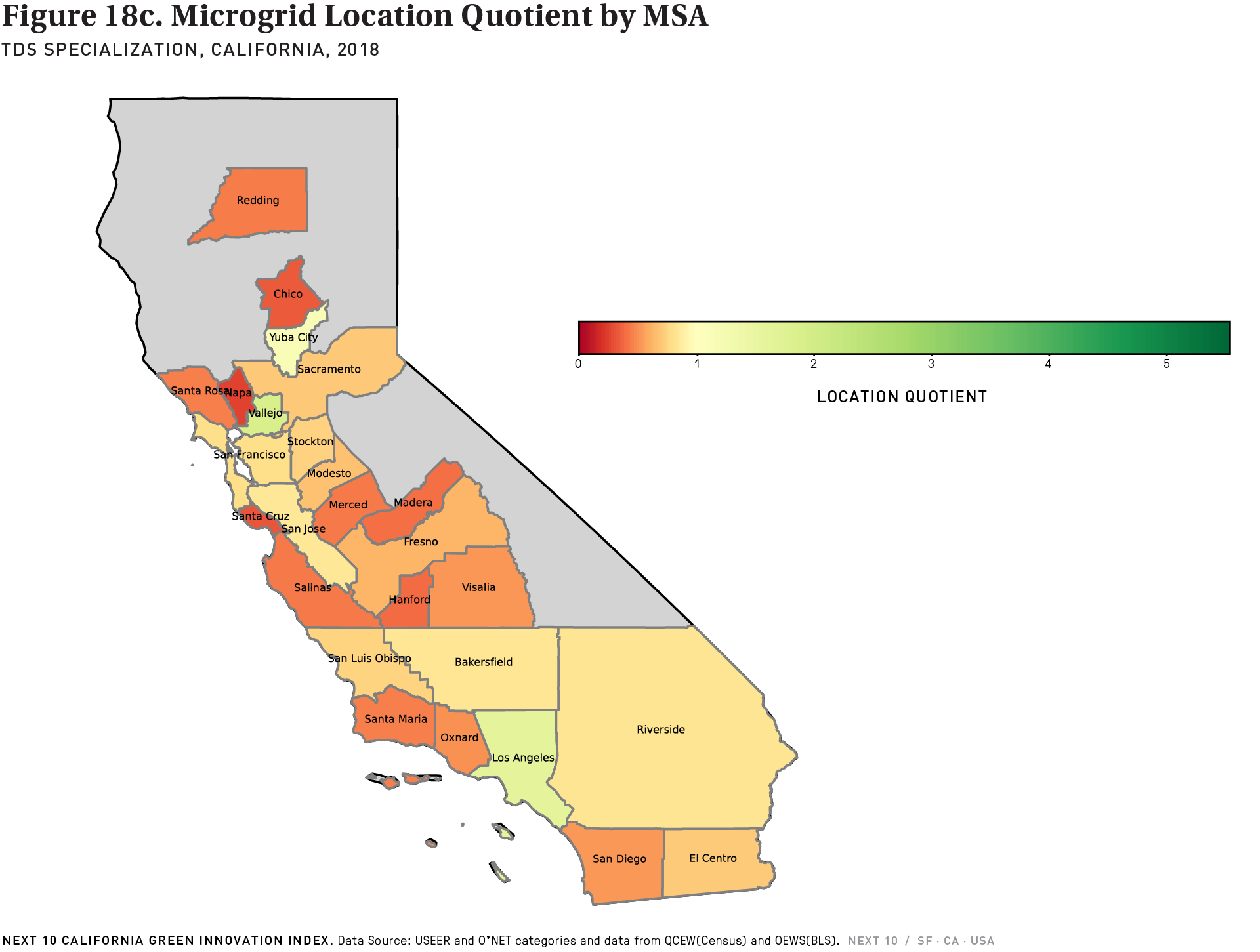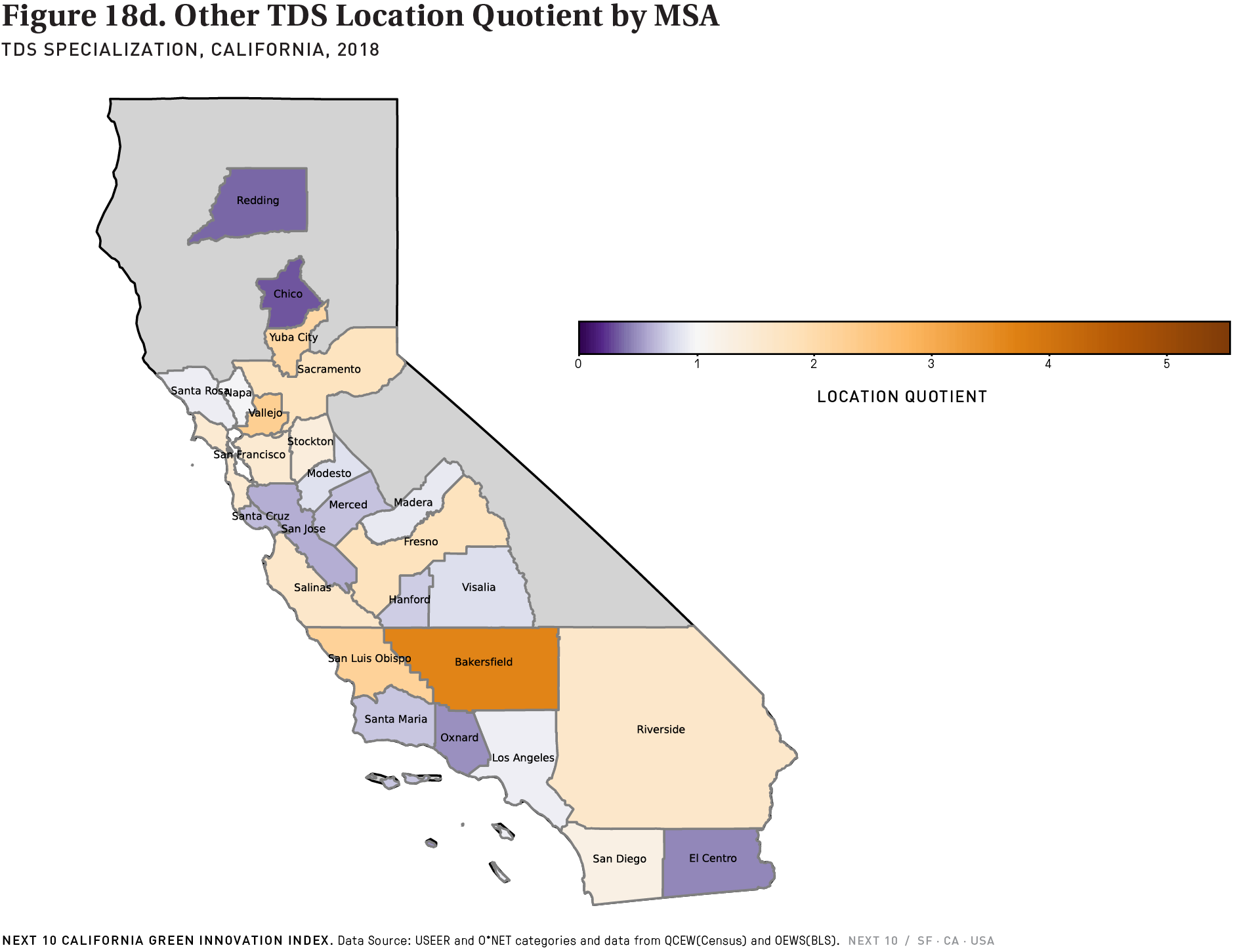Highlights
- Most California regions employ more TDS workers than would be expected based on their populations—almost all regions have storage LQs above one and only Hanford is underrepresented in storage employment. As with power generation, there is a strong connection between energy storage facilities and high employment density. For example, Vallejo’s Mare Island storage facility41 would most likely be responsible for most of its 356 storage workers. State initiatives might matter; residential energy storage became available in Vallejo in 2019 and was celebrated by Mayor Pippin Dew as a job opportunity.42 Vallejo’s 2012 Climate action plan connected business owners with information about smart grid rebates as a way of lowering barriers to adoption. California’s near universal specialization in energy storage has surely been influenced by state policymaking, as well. Most notably, 2010’s Assembly Bill 2514 required that the state’s investor-owned utilities acquire 1325 MW of energy storage by 2020.43
- A few regions do specialize in smart grid employment: Vallejo, Red Bluff, Yuba City, Santa Rosa, and Los Angeles. PG&E, a leader in smart grid integration, has been involved in remediation of old gas manufacturing plants in Red Bluff and Fresno, which likely accounts for higher smart grid LQs in these regions.44 The Los Angeles Department of Water and Power has partnered with CalTech, UCLA and USC on a federally-subsidized, $120 million smart grid innovation project designed to help scale metering and pricing technologies.45 Such initiatives support jobs in R&D, but also marketing and education. The job creation potential of smart grid projects has long been recognized by local economic development officials.
- Microgrid employment is generally not a major proportional source of total green jobs in the state—only 1.8 percent of all California TDS jobs are related to microgrid technology. That said, microgrid employment is specialized in Vallejo, Los Angeles, Red Bluff and Yuba City. Adoption of microgrid technologies in California has been sporadic and tends to be administered at the hyper-local level, by households and individual institutions.46
41 “Island Energy, Energy Solutions for Mare Island.” Available at: https://islandenergy.com/
42 “Two More California Cities Join MCE Community Choice Aggregation Program.” Clean Energy Exchange. December 3, 2019. Available at: https://cleanpowerexchange.org/two-more-california-cities-join-mce-community-choice-aggregation-program/
43 “AB-2514: energy storage systems.” California State Legislature. Chaptered September 29, 2010. Available at: https://leginfo.legislature.ca.gov/faces/billTextClient.xhtml?bill_id=200920100AB2514
44 “2018 Corporate Responsibility and Sustainability Report.” PG&E. Available at: https://www.pgecorp.com/corp_responsibility/reports/2018/assets/PGE_CRSR_2018.pdf
45 “Los Angeles Department of Water and Power: Smart Grid Regional Demonstration. Available at: https://www.smartgrid.gov/project/los_angeles_department_water_and_power_smart_grid_regional_demonstration
46 Cart, J. “Five things to know about microgrids.” CalMatters. November 1, 2019. Available at: https://calmatters.org/environment/2019/11/california-wildfires-pge-blackouts-microgrids/
Opportunity
- It does not necessarily take a long time to see meaningful increases in energy storage employment. With 8,704 energy storage jobs, Nevada is now the most specialized energy storage state in the nation, but as of 2016, it only had 504 jobs in the sector. California’s initial investments in storage could quickly scale into a larger specialized industry statewide. Other TDS investments could help expand related industries. Over the past year, the California Public Utilities Commission (CPUC) has begun to roll out programs in support of Senate Bill 133947 that will induce the production of more microgrids, including a $200 million energy fund to sponsor new systems.48 In Los Angeles County, officials have recently proposed the creation of microgrid energy commission49 for Southern California, that would support system development and facilitate approval. LADWP has continued to invest in smart grid technologies with a recent focus of its efforts placed on expanding access to smart systems in underserved communities.50 These efforts could improve labor force participation in TDS in underrepresented communities. Black workers are currently underrepresented in the TDS labor force, as are women.51 For example, nationwide, only three percent of power-line installers and repairers and six percent of insulation workers are Black. The number is only two percent for women among the first group and four percent among the second.52
47 “SB-1339 Electricity: microgrids: tariffs.” California State Legislature (2017-18). Available at: https://leginfo.legislature.ca.gov/faces/billTextClient.xhtml?bill_id=201720180SB1339
48 “Resiliency and Microgrids.” California Public Utilities Commission. Available at: https://www.cpuc.ca.gov/resiliencyandmicrogrids/
49 Wood, E. “US’ Largest County — Los Angeles — Proposes Agency to Support Microgrids in a Large Swath of California. Microgrid Knowledge. September 14, 2021. Available at: https://microgridknowledge.com/regional-microgrid-agency-los-angeles/
50 “LADWP Launches Groundbreaking LA100 Equity Strategies Initiative.” LADWP News. June 23, 2021. Available at: https://www.ladwpnews.com/ladwp-launches-groundbreaking-la100-equity-strategies-initiative/
51 “Appendix A: Discussion of USEER Methodology.” USEER 2021, p. A-74. 2021. Available at: https://www.energy.gov/sites/default/files/2021-07/USEER%202021%20Appendices.pdf
52 “How Green Energy Jobs Can Power an Equitable COVID-19 Recovery.” Brookings Institute. September 10, 2020. www.brookings.edu/blog/the-avenue/2020/09/10/how-clean-energy-jobs-can-power-an-equitable-covid-19-recovery/



